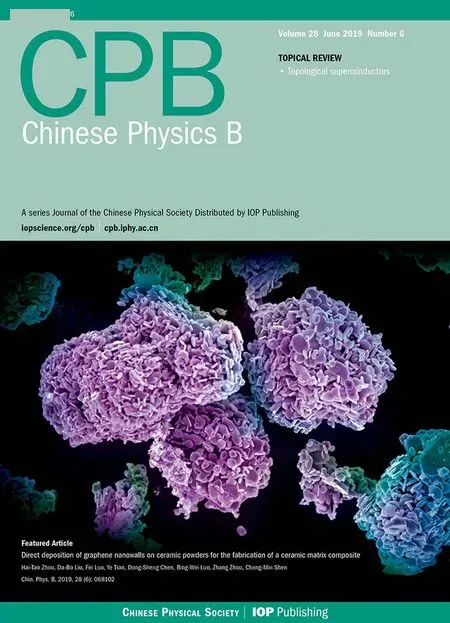Supercontinuum generation of highly nonlinear fibers pumped by 1.57-µm laser soliton∗
Song-Tao Fan(樊松涛),Yan-Yan Zhang(张颜艳),Lu-Lu Yan(闫露露),Wen-Ge Guo(郭文阁),Shou-Gang Zhang(张首刚),and Hai-Feng Jiang(姜海峰),†
1Key Laboratory of Time and Frequency Primary Standards,National Time Service Center,Chinese Academy of Sciences,Xi’an 710600,China 2School of Astronomy and Space Sciences,University of Chinese Academy of Sciences,Beijing 100049,China
Keywords:highly nonlinear fiber,erbium- fiber laser,supercontinuum generation
1.Introduction
Supercontinuum(SC)generation in microstructured optical fibers(MSFs)and HNLFs pumped with femtosecond pulses has been an area of intense interest for many years and has led to many breakthroughs in numerous applications across diverse fields,such as optical communication[1-3]optical coherence tomography,[4,5]frequency metrology,[6-10]and gas sensing.[11,12]In particular,an SC over an octave span is a prerequisite for optical frequency combs,enabling precise phase and frequency measurements in the optical domain.
The SC generation in MSFs in terms of fiber type,pulse duration,and pumping laser wavelength has been extensively studied both theoretically and experimentally in recent years.[13-18]The importance of the relative detuning between pumping laser wavelength and the fiber ZDW has been highlighted.[19]When the pulse laser pumps in the anomalous regime of the fiber,soliton dynamics would dominant the spectral broadening.If the pumping pulse is in the vicinity of fiber ZDW,mixed normal group velocity dispersion(GVD)and soliton dynamics would mainly contribute to the spectral broadening.For the case of normal GVD pumping,the spectral broadening arises from the interaction between self-phase modulation(SPM)and normal GVD.
Very recently,Er- fiber-based optical frequency combs(OFCs)has received increasing attention due to their good performance in reliability and compactness,[20,21]where SC generation of HNLFs pumped with such OFCs is often required for application.However,the SC generation is a complicated nonlinear optical process with strong interaction between nonlinear and dispersion properties of nonlinear fibers.It is dif ficult to choose the appropriate nonlinear fibers for various applications based only on the fibers’datasheet.Therefore,we have to test the HNLF in advance before it can be used for subsequent work.
To determine how to choose proper HNLFs for Er- fiberbased OFC applications,in this paper,we perform a detailed experimental study of the SC generation in five HNLFs pumped with 1.57-µm laser solitons.Our results are in good agreement with previous theoretical analyses and what has been observed in MSFs.We also find the ZDW of fiber has an important influence on the SC structure and energy distribution for given pump source,which can serve as guidelines for choosing the appropriate HNLFs for SC generation and using them properly.
2.Experimental setup
In our experiment,we first measured SC generation in four different kinds of commercial HNLFs,designated as HNLF1,HNLF2,HNLF3,and HNLF4.The main optical characteristics of these four HNLFs are listed in Table 1.The experiment setup is schematically shown in Fig 1,which consists of a femtosecond laser,an erbium-doped- fiber amplifier(EDFA),and a piece of HNLF to generate supercontinum.The laser seed source is a mode-locked erbium-doped- fiber-based oscillator that produces a series of 4.78-ns spaced laser pulses with a center wavelength at 1570 nm.[22]Because the output power of the oscillator is low(generally∼50 mW)and not high enough to generate SC,an EDFA is used here to amplify the seed source.The EDFA is a nonlinear optical amplifier,which is pumped by four 976-nm pigtailed diode lasers via both forward and backward directions.The pump solitons can be tuned by changing the pump power of EDFA,and the maximum output power can be gained to 420 mW.The corresponding pulse duration(full width at half maximum)ranges from 53 fs to 1 ps,as shown in Fig.1(b).Then,the output pigtail fibers of the amplifier is spliced directly to the HNLFs to form an all- fiber con figuration.

Table 1.Optical parameters of HNLF.
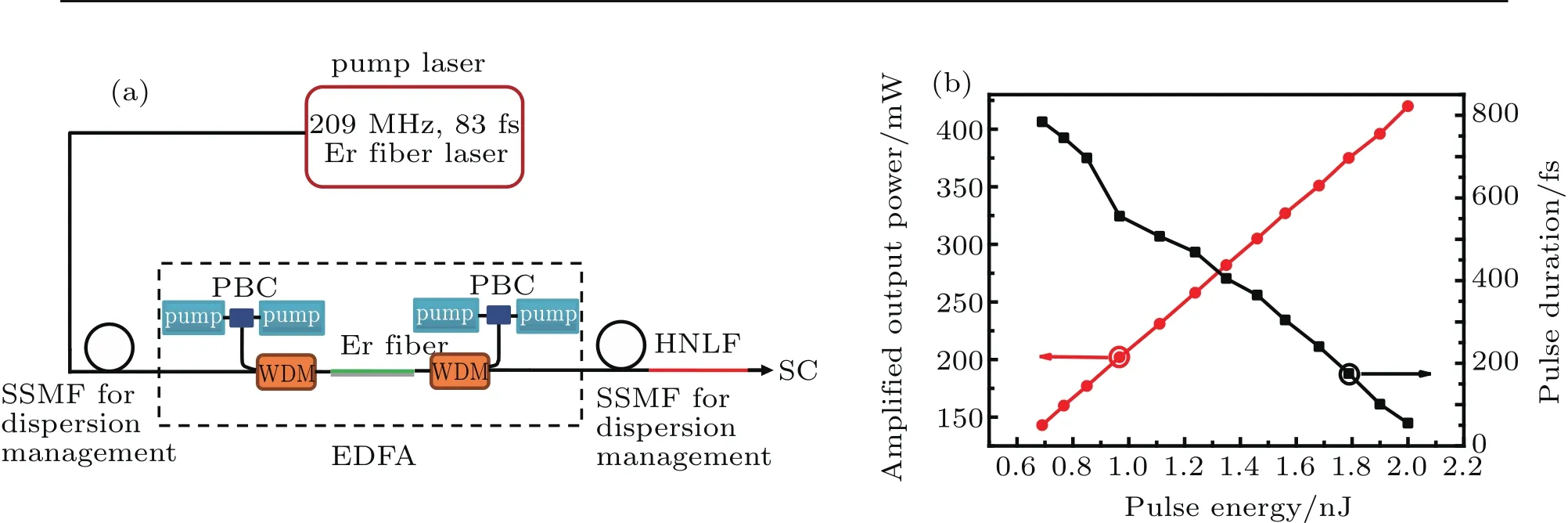
Fig.1.(a)Experimental setup and(b)dynamic range of the pump laser,including ampli fied output power and pulse duration.SSMF:standard single-mode fiber;WDM:wavelength division multiplexer;PBC:polarization beam combiner.
3.Results and discussion
We first send ampli fied light into given-length HNLFs and observe the output characteristics of generated continuum.The output characteristic of the SC are measured directly at the end of HNLFs.Here,all spectra are measured with two optical spectrum analyzers(models AQ6370 and AQ6376,Yokogawa Electric Corp.,Tokyo,Japan),and are normalized by the rmalpower-detector-measured optical power.The output power is measured by a optical power meter(PM100D,Thorlabs).Figure 2 shows the SC generation with four types of given-length commercial HNLFs versus different SC output powers.
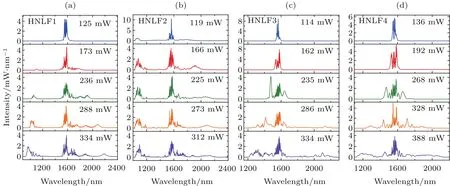
Fig.2.The SC formation processes versus SC output power for given-length of the HNLFs.(a)1 m,HNLF1;(b)2 m,HNLF2;(c)1.5 m,HNLF3;(d)1.5 m,HNLF4.The incident powers are 157 mW,216 mW,295 mW,360 mW,and 420 mW,respectively.
For fiber HNLF1,we obtain 334-mW SC under maximum pump power within only 1-m length of HNLF1 and the optical to optical conversion efficiency is 80%.Figure 2(a)shows the SC evolution in terms of SC output power.When the SC output power is less than 125 mW,the spectral broadening is limited.As SC output power increases to 173 mW,an isolated spectral peak is split at 1630 nm.At the same time,new spectral component emerges at 1100 nm.This is the characteristic of soliton fission.Continue increasing the SC output power,the spectrum is sharply broadened,and several red-shifted Raman peaks appear in the long wavelength direction.Simultaneously,more spectral components in short wavelength direction appear due to dispersion wave generation and move farther to the blue side.The final spectrum covers from 930 nm to 2250 nm,which exceeds an octave.
For fiber HNLF2,312-mW SC is obtained under maximum pump power with the utility of 2-m length of HNLF2,and the optical to optical conversion efficiency is about 75%.Figure 2(b)shows the SC evolution of fiber HNLF2 in terms of SC output power.This shows that fiber HNLF1 and HNLF2 has a similar spectral evolution process.At a low output power,the spectrum is barely broadened.When the output power is higher than a certain level,the spectrum is broadened broadly.On the red side of input light wavelength,the spectrum is associated with a clear continuous red shift.At the same time,distinct spectral components emerge on the blue side of input light wavelength.Finally,the output SC covers from 1020 nm to more than 2400 nm,more details cannot be observed for the working wavelength limitation of optical spectrum analyzer.
For fiber HNLF3,an SC of 334 mW is output under maximum pump power within 1.5-m length.The optical to optical conversion efficiency is 80%.The output spectrum evolution versus continuum output power is shown at Fig.2(c).This shows that at the beginning stage of spectrum broadening,a pair of symmetrical peaks are produced on both sides of the input light wavelength(1530 nm,1580 nm).Four-wave mixing(FWM)is possible to be responsible for the spectral broadening at this period.When continuing to increase the pump power,the spectrum broadens asymmetrically to both short and long wavelength direction.Raman peaks(2000 nm,2100 nm)are generated at long wavelength direction far away from input wavelength.A rich spectral component is generated at short-wave direction,and most of the spectral energies are concentrated on this side.Finally,the output SC covers from 1200 nm to 2240 nm.
For fiber HNLF4,we obtained 388-mW SC under maximum pump power within 1.5 m,the corresponding optical to optical conversion efficiency is up to 93%.Figure 2(d)shows the output spectrum evolution against pump power.Note that the two symmetrical spectrum peaks are firstly generated at 1530 nm and 1590 nm.Then,more pairs of symmetrical spectral components emerge at 1500 and 1610 nm,1470 nm and 1660 nm.By further increasing the pump power,the spectrum is spread symmetrically to both sides of the input light wavelength all the time.This is the characteristic of SPM.In the end,the continuum expands from 1120 nm to 2120 nm.Although the SC does not reach an octave,it has a good spectral flatness.
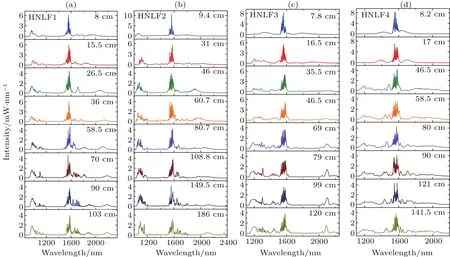
Fig.3.Spectrum evolution in HNLFs under a certain input light power of 420 mW:(a)HNLF1;(b)HNLF2;(c)HNLF3,and(d)HNLF4.
In addition,we have studied evolution of the SC during propagation with a constant incident power of 420 mW.The spectra at HNLFs’output(see Fig.3)are recorded while the HNLFs are cut step by step.It shows that HNLF1 and HNLF2 make ef ficiently the conversion at short wavelength side(980 nm and 1100 nm,respectively)within 10-cm propagation,while HNLF3 makes it within 16-cm propagation.HNLF3 has longer conversion length than the former two HNLFs,because the incident light wavelength closer to its ZDW.At the long wavelength side,further propagation is associated with a continuous redshift due to the effect of Raman scattering.No broadening observed after 46-cm propagation for HNLF4,which is attributed to the power density of the long wavelength soliton decrease due to chromatic dispersion.All these experimental results are in good agreement with previous theoretical analyses on relationship between ZDW and SC evolution.
With the utility of four types of HNLF,we observed diverse SC evolution process and obtained SC with different spectral structure and energy distribution.In the case where the SC pump source is the same,the SC is mainly determined by fiber parameters.The ZDWs of fiber HNLF1 and HNLF2 are 1350 nm and 1405 nm,separately.So the input light wavelength(1570 nm)is in the anomalous region of these fibers.This is why both fibers have similar SC formation process.At this regime,soliton-related dynamics are mainly responsible for the SC generation.The combined action of high-order dispersion and Raman scattering induces the pulse distortion and soliton fission.[23]As the input pulse power increases,the fission solitons experience a continuous shift to longer wavelength under the effect of the soliton self-frequency shift.[24-27]At the same time,due to the large distance between the ZDW and input wavelength,the strong high-order dispersion leads to the energy of some solitons transferred to the short-wavelength side and forms a new frequency component,which is the dispersion wave.[28]This can enhance the spectral width on short wavelength.Therefore,such fibers are suitable when experimentally requires an SC source that does not require spectral flatness and flexibility,such as the detection of carrier envelop offset frequency in OFC.The ZDW of fiber HNLF3 is 1560 nm,the input light wavelength is just located at the vicinity of ZDW of this fiber.Normal GVD and soliton dynamics are dominant for SC generation.At the initial stage of spectral broadening,FWM is mainly responsible for the spectrum broadening.Then,soliton dynamics contribute the spectrum broadening to long wavelength side and radiate energy to the short wavelength side.At the same time,the SPM,cross phase modulation(XPM),and normal dispersion enrich the spectrum of short wavelength side.For fiber HNLF4,it has no ZDW.Therefore the input wavelength is within normal dispersion regime of this fiber.And the interaction between SPM and normal dispersion is dominant for the SC generation.Hence,the output SC exhibits spectrally symmetric properties.This type of fiber is suitable for applications where supercontinuum flatness is critical.
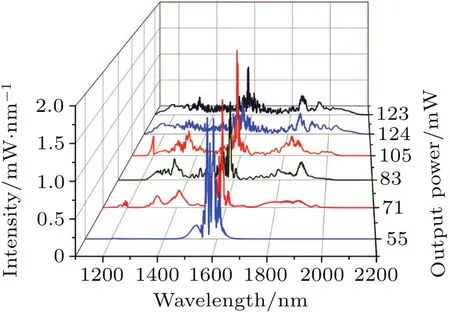
Fig.4.The SC formation process versus SC output power for 1.5-m length of HNLF5.
When combining the fiber parameters and the spectral broadening mechanism,the location of fiber ZDW and the dispersion magnitude is crucial to the SC structure and energy distribution.The further that the fiber ZDW deviates from the input light wavelength,the dispersion wave will be generatedtowards shorter wavelength. Hence, the generated SC will cover a wider range.When the fiber ZDW is closer to the input light wavelength,the bandwidth of output SC will be narrower and the spectral flatness of short band will be better.To verify this fact,we preform another SC generation experiment by using a 1570 nm,201-MHz femtosecond pulse laser.After being ampli fied to 350 mW,it is injected into fiber HNLF5(the optical parameters of this fiber is shown at Table 1).It can be seen that the ZDW of fiber HNLF5 is 1525 nm,which is between fiber HNLF2 and HNLF3.The output spectrum evolution is shown in Fig.4.At the maximum output power,a dispersion wave at 1200 nm can be observed(slightly larger than 1100 nm of fiber HNLF2).Due to the smaller dispersion slope,the spectral components at 1200 nm to 1600 nm are also abundant.A SC covering from 1100 nm to 2150 nm is obtained.This is larger than the coverage of fiber HNLF3,which is in line with our expectations.
4.Conclusion
In conclusion,we experimentally studied the SC generation in five kinds of HNLF by pumping with 1.57-µm laser solitons.We explore the SC evolution process in terms of SC output power and give a detailed analysis.The output SC of fiber HNLF1 and HNLF2 are exceeding an octave(HNLF1:930 nm to 2250 nm,HNLF2:1020 nm to 2400 nm).The other fibers all output SC cover more than 1000 nm(HNLF3:1200 nm to 2240 nm,HNLF4:1120 nm to 2120 nm,HNLF5:1100 nm to 2150 nm).Most of spectral output power is greater than 310 mW,corresponding light to light conversion efficiency exceeds 80%.Three different SC formation processes were observed in the experiment.Comparing optical parameters of these fibers,the ZDW of fiber has an important influence on the SC structure and energy distribution for given pump source.The bandwidth of the output SC gets narrower as the fiber ZDW moves toward the input light wavelength.Simultaneously,the spectral flatness of short wavelength becomes better.We hope that our results can provide guidance for the selection of appropriate HNLF for different applications based on erbium- fiber-based optical frequency combs.
- Chinese Physics B的其它文章
- Theoretical study of overstretching DNA-RNA hybrid duplex∗
- influence of carbon coating on the electrochemical performance of SiO@C/graphite composite anode materials∗
- Spin glassy behavior and large exchange bias effect in cubic perovskite Ba0.8Sr0.2FeO3-δ∗
- Aging mechanism of GaN-based yellow LEDs with V-pits∗
- Magnetotransport properties of graphene layers decorated with colloid quantum dots∗
- Temperature-dependent subband mobility characteristics in n-doped silicon junctionless nanowire transistor∗

